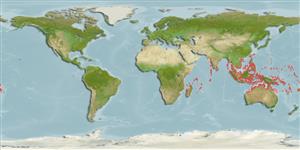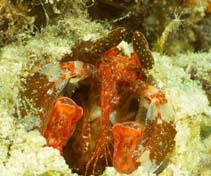Lysiosquillina lisa Ahyong & Randall, 2001
| Native range | All suitable habitat | Point map | Year 2050 |

|
| This map was computer-generated and has not yet been reviewed. |
| Lysiosquillina lisa AquaMaps Data sources: GBIF OBIS |
Classification / Names Κοινά ονόματα | Συνώνυμα | CoL | ITIS | WoRMS
Malacostraca | Stomatopoda | Lysiosquillidae
Environment: milieu / climate zone / εύρος βάθους / distribution range Οικολογία
Υφαλόφιλο(α); εύρος βάθους 14 - 25 m (Αναφ. 3606). Tropical
Distribution Χώρες | Περιοχές FAO | Οικοσυστήματα | Παρουσίες | Εισαγωγές
Indo-West Pacific: Andaman Sea to Papua New Guinea and the Philippines.
Length at first maturity / Μέγεθος / Weight / Age
Γεννητική Ωρίμανση: Lm ? range ? - ? cm
Life cycle and mating behavior Γεννητική Ωρίμανση | Αναπαραγωγή | Γεννοβολία | Eggs | Γονιμότητα | Larvae
Main reference
Αναφορές | Συντονιστής | Συνεργάτες
Ahyong, S.T. and E.J. Randall 2001 Lysiosquillina lisa, a new species of mantis shrimp from the Indo-West Pacific (Stomatopoda: Lysiosquillidae). Journal of South Asian Natural History 5(2):167-172. (Αναφ. 3607)
IUCN Red List Status
(Αναφ. 130435: Version 2025-1)
CITES status (Αναφ. 108899)
CMS (Αναφ. 116361)
Threat to humans
Human uses
| FishSource |
Εργαλεία
Περισσότερες πληροφορίες
Σύσταση δίαιτας
Κατανάλωση τροφής
Θηρευτές
Max. ages / sizes
Length-weight rel.
Length-length rel.
Length-frequencies
Mass conversion
Αφθονία
Διαδικτυακές πηγές
BHL | BOLD Systems | CISTI | DiscoverLife | FAO(Publication : search) | Fishipedia | GenBank (genome, nucleotide) | GloBI | Gomexsi | Google Books | Google Scholar | Google | PubMed | Δέντρο Ζωής | Wikipedia (Go, αναζήτηση) | Zoological Record



